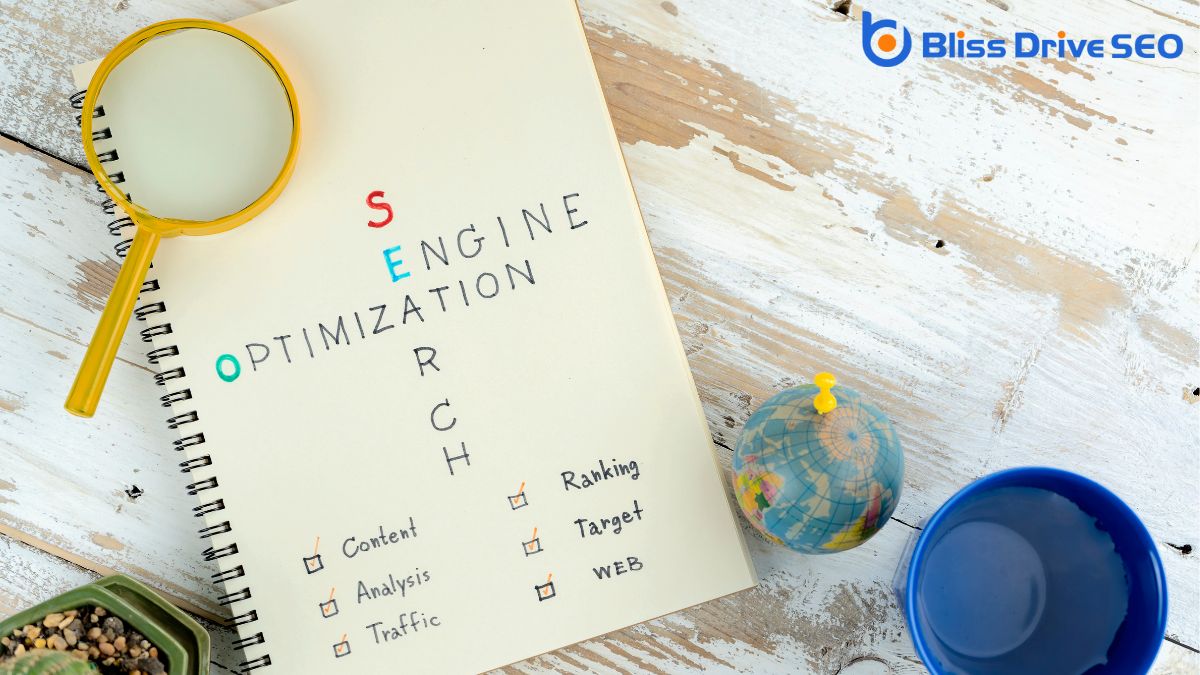Learn More About Us

To start an SEO strategy, begin with thorough keyword researchThe process of finding and analyzing search terms that people enter into search engines. to align your content with what your audience is searching for. Use tools like Google Keyword Planner to find high-volume, moderate-competition keywordsWords or phrases that users type into search engines to find information.. Analyze your competitors by exploring their traffic, backlinksLinks from other websites pointing to your website, crucial for SEO., and content strategies. Optimize your on-page elements, such as titles and meta descriptions, and guarantee a logical site structure. Build quality backlinks through methods like guest bloggingWriting and publishing articles on other websites to reach a new audience. and networking. Finally, monitor your SEO progress with tools like Google AnalyticsA web analytics service offered by Google that tracks and reports website traffic., adjusting strategies as needed. By doing these steps, you'll set a strong foundation for more advanced SEO tactics.
Diving into keyword research is like looking for treasures in a vast digital sea. You want to find the right words and phrases that your audience uses when searching for products or information related to your business. Start by brainstorming a list of terms relevant to your niche. Consider the words your customers might use when they're looking for what you offerThe specific product or service being promoted by affiliates.. This foundational step helps you align your content with what people are genuinely interested in.
Once you've got your list, use tools like Google Keyword Planner or Ubersuggest to expand your ideas. These tools provide insights into search volume and competition, allowing you to refine your list. Look for keywords with high search volume but moderate competition. These are your golden opportunities—phrases that many people search for but few companies target effectively.
Moreover, think about long-tail keywordsLonger, more specific keyword phrases that are less competitive and often more targeted.. These are longer and more specific phrases that are less competitive and often leadA potential customer referred by an affiliate who has shown interest in the product or service but h... to better conversionThe completion of a desired action by a referred user, such as making a purchase or filling out a fo... rates. They're your hidden gems, attracting users who are closer to making a decision.

Understanding your competitors' SEO tactics can reveal valuable insights for your own strategy. Start by identifying who your main competitors are. These are businesses targeting the same audience with similar products or services. Use tools like SEMrush or Ahrefs to analyze their website traffic, top-ranking keywords, and backlink profiles. Look at their content strategyA plan for creating, publishing, and managing content to meet business goals., too—what topics are they covering, and how frequently are they publishing?
Pay attention to their on-page elements, like title tags and meta descriptions, since these can influence search engine rankingsThe position at which a website appears in the SERP.. By examining their approach, you can spot trends or gaps in their strategy. Are they strong in certain areas but lacking in others? This can be an opportunity for you to capitalize on their weaknesses.
Also, consider their user engagementThe level of interaction and involvement users have with social media content.. Check their social media presence and how they interact with their audience. This might give you ideas for improving your own engagementThe interactions that users have with a brand’s content on social media. tactics.
Often, the foundation of a successful SEO strategy lies in optimizing on-page elements. These elements are essential because they help search engines understand your content and rank it accordingly. Start by focusing on your title tags. Make sure they're descriptive and include your main keyword, giving both users and search engines a clear idea of your page's content.
Next, pay attention to your meta descriptions. While they don't directly affect rankings, they influence click-through rates, so keep them engaging and relevant. Use keywords naturally and make sure they align with your page content.
Headings, like H1 and H2 tags, also play a vital role. They break up your content, make it readable, and help search engines grasp your page's structure. Use keywords in these headings where they make sense.
Don't overlook image optimization. Use descriptive file names and alt tags to help search engines understand your visuals. This can also enhance accessibility.
Lastly, focus on URL structure. Short, descriptive URLs containing relevant keywords are easier for both users and search engines to comprehend. By optimizing these on-page elements, you establish a strong foundation for your SEO strategy.
Improving your site's structure is vital for better SEO performance. Start by optimizing your URL structure to make sure it's clear and descriptive, making it easier for search engines and users to understand.
Next, enhance your internal linkingLinks that connect different pages on the same website. to guide visitors smoothly through your content while boosting your site's authority.
Crafting a well-optimized URL structure is an essential step in enhancing your site's overall organization and user experience. A clear and logical URL not only benefits users by making navigation straightforward but also helps search engines understand your site's hierarchy and content.
To optimize your URL structure effectively, consider these key practices:
After optimizing your URL structure, it's time to focus on enhancing internal linking to further improve your site's organization and user experience. Internal links connect different pages within your website, guiding users and search engines alike. A well-thought-out internal linking strategy can help visitors easily navigate your site and discover more of your content, boosting engagement and time spent on your site.
To start, identify key pages you want to highlight, like cornerstone content or high-converting pages. Ensure these pages are easily accessible from other relevant pages. Use descriptive anchor textThe clickable text in a hyperlink, important for SEO as it provides context for the linked page.—these are the clickable words in a hyperlink—to provide context for what's on the linked page. Avoid using generic phrases like "click here," which don't inform users or search engines about the linked content.
Next, create a logical hierarchy. Consider how your pages connect and aim for a balanced link distribution across your site. This structure helps search engines better understand your content's importance and relevance. Regularly update your internal links as you add new content to maintain a cohesive structure.
To build quality backlinks, start by identifying relevant link opportunities that align with your niche.
Leverage guest blogging tactics to gain exposure and earn valuable links.
Additionally, utilize influencer partnershipsCollaborations between brands and social media influencers to promote products and reach new audienc... to expand your reach and strengthen your site's authority.
Building quality backlinks is an essential step in enhancing your website's SEO strategy. To start, you need to identify relevant link opportunities that can boost your search engine rankings. These links should come from authoritative and relevant sites within your niche. Here's how you can find these valuable opportunities:
Once you've identified relevant link opportunities, it's time to tap into guest blogging tactics to build quality backlinks. Guest blogging involves writing content for another website in your industry. By doing this, you gain exposure to a new audience while earning a valuable backlink to your site.
Start by researching reputable blogs within your niche that accept guest posts. Confirm these sites have high domain authority and engage with your target audience.
When proposing a guest post, craft a personalized pitch that highlights your expertise and the value you'll bring to their readers. Focus on creating compelling, informative content that aligns with the host site's tone and audience. Remember, quality matters more than quantity. A well-written post on a respected site will benefit your SEO strategy far more than multiple posts on low-quality sites.
Once your post is published, engage with the readers' comments and share the article on your social media platforms. This interaction can build relationships and increase your visibility. By consistently leveraging guest blogging, you'll not only enhance your backlink profile but also establish yourself as an authority in your field.
Partnering with influencersIndividuals with the power to affect the purchasing decisions of others due to their authority, know... can significantly enhance your backlink strategy, as they often have a dedicated and engaged following. By collaborating with the right influencers, you can tap into new audiences and leverage their authority to build quality backlinks. When influencers share your content or mention your brand, it signals credibility to search engines, boosting your SEO efforts. It's essential to find influencers whose values align with your brand for a genuine partnership that resonates with their audience.
To successfully utilize influencer partnerships, consider these steps:

To guarantee your SEO efforts are effective, regularly monitor your strategy and make necessary adjustments. Start by using analyticsThe systematic computational analysis of data or statistics to gain insights and support decision-ma... tools like Google Analytics or SEMrush. These tools provide insights into how well your keywords are performing, your website's traffic, and user behavior.
Keep an eye on your rankings and adjust your keywords if you notice a drop or stagnation.
Additionally, pay attention to changes in search engine algorithms. Google and other search engines frequently update their algorithms, which can impact your rankings. Stay informed by following SEO news and updates. If an update affects your site, don't panic. Analyze what's changed and tweak your strategy accordingly.
Engage with user feedback and behavior on your site. If users aren't staying long or converting, it might indicate issues with your content or site structure. Consider A/B testingA method of comparing two versions of a web page or app against each other to determine which one pe... different elements like titles or calls to action to see what works best.
To kick off your SEO strategy, start by diving into keyword research to understand what your audience is searching for. Keep an eye on your competitors to uncover their strategies and find opportunities for improvement. Optimize your on-page elements, ensuring your content is engaging and relevant. Enhance your site's structure for better user experience and search engine crawlingThe process by which search engines discover new and updated web pages to index.. Focus on building quality backlinks to boost your site's authority. Finally, regularly monitor and tweak your strategy to stay ahead.
